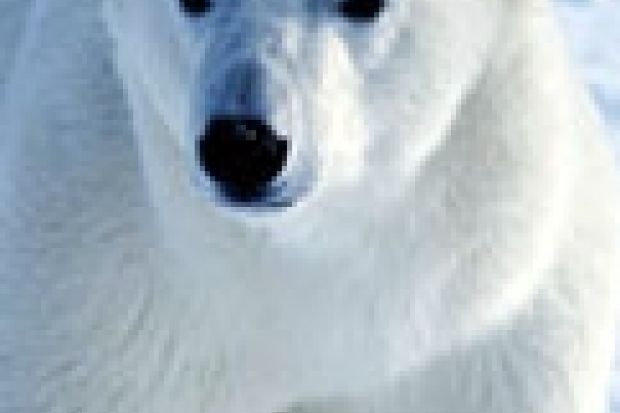The professor from Florida was puzzled. As postgraduate students arrived at the university refectory for lunch, they hung their rifles next to their coats. "You allow your students to carry rifles here?" he asked. "Back home we are trying to disarm ours."
An unusual requirement for new arrivals at the world's most northerly university is that they have to learn to shoot. No one walks in the barren hills around the main settlement, Longyearbyen, without a gun, and it is recommended to carry one in Longyearbyen itself. Polar bears outnumber the 2,700 inhabitants of Spitsbergen, the biggest island in Norway's Svalbard archipelago.
The greatest danger is from hungry mothers with cubs and from juveniles that have been left by their mothers before they have learnt how to hunt seals, the polar bears' staple diet.
Stringent safety precautions were introduced after two women students were attacked by a young male polar bear while out walking near Longyearbyen two years ago. One managed to scramble down a rocky slope and escape with a broken leg. The other was killed.
Since then, the first week of all students at Unis (University Courses on Svalbard) is taken up with survival lessons, including the use of what are known as "welfare rifles".
"The first day is spent learning to shoot," said Lasse Loennum, Unis's director. "To shoot bigger animals you need a large calibre rifle such as a Mauser. You need five bullets, with another 20 in your pocket. The students learn how to put trip wires around a tent, how to use flares, pack sledges, signal a helicopter for assistance and repair snow-mobiles. There is an examination at the end of the week."
Despite these daunting demands, Unis is expanding, according to Mr Loennum, who has been seconded from Tromso University and is looking for more students, especially from the United Kingdom.
Unis is funded by Norway, which holds sovereignty over Svalbard and wishes to see the population increase. Coal mining, the traditional industry, is in decline, and the government has identified higher education, along with Arctic research and limited tourism, as a means of maintaining a strong presence in the archipelago.
Svalbard has strategic significance as it controls the route to the Barents Sea from the Atlantic and the fact that Russia exercises coal mining rights in Spitsbergen under an international treaty is an added reason for Oslo's determination to emphasise its stake here.
Located 380 km from the North Pole, Spitsbergen is 600km north of Fairbanks, Alaska, the most northerly university in the United States. Yet it has scheduled flights from mainland Norway, good roads in and around Longyearbyen, and hotels.
Because of the Gulf Stream, it is relatively warm. "When it is -20 oc here it is -40 in Greenland," said Mr Loennum. "It is not only an excellent platform for Arctic research, it is the Arctic tropics."
Yet of 234 students from 22 countries last year, none was from the UK, and this year there are just two. About half are from Norway.
"The UK is rather conservative in accepting overseas segments as part of its courses," said Mr Loennum. "We'd welcome more because they are very well trained in basic science. We invite guest lecturers from the UK and they go back and spread the gospel. So now we have connections."
Unis has links with University College London, the University of Wales at Aberystwith, Bristol University's glaciology centre and the Institute of Terrestrial Ecology at Banchory, Aberdeenshire.
Opened in 1993 as a joint venture of the four Norwegian universities of Oslo, Bergen, Tromso and Science and Technology (formerly Trondheim), Unis has four departments: geophysics, geology, biology and technology, all specialising in Arctic studies.
It offers 35 courses, at graduate and undergraduate level, and has about 50 MSc and PhD students. All courses are free and in English. Students have to pay for food, accommodation and travel. Future plans include a science centre, expected to open in 2002.
Mr Loennum added: "Svalbard has the world's smallest university with the world's largest laboratory, consisting of the 62,000 km2 of Svalbard and its surrounding waters."
For those who take to shooting, there is a bonus. Svalbard's reindeer are culled on a "renewable and sustainable" basis and anyone staying for more than six months may apply for a licence from the governor to shoot one.
On the day of our interview, Mr Loennum had just obtained a licence, and had asked if he could bring the interview forward because he had other business to attend to later in the day.
So I was not surprised by an email I later received attaching a photograph of the aurora borealis and the message: "I shot a nice two-and-a-half-year-old Svalbard reindeer buck."
Register to continue
Why register?
- Registration is free and only takes a moment
- Once registered, you can read 3 articles a month
- Sign up for our newsletter
Subscribe
Or subscribe for unlimited access to:
- Unlimited access to news, views, insights & reviews
- Digital editions
- Digital access to THE’s university and college rankings analysis
Already registered or a current subscriber?
